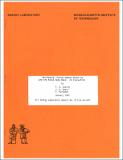| dc.contributor.author | Cowing, Thomas G. | en_US |
| dc.contributor.author | Dubin, Jeffrey A. | en_US |
| dc.contributor.author | McFadden, Daniel | en_US |
| dc.contributor.other | Massachusetts Institute of Technology. Energy Laboratory. Utility Systems Program. | en_US |
| dc.date.accessioned | 2011-01-14T22:38:49Z | |
| dc.date.available | 2011-01-14T22:38:49Z | |
| dc.date.issued | 1982 | en_US |
| dc.identifier.uri | http://hdl.handle.net/1721.1/60589 | |
| dc.description.abstract | The purpose of this report is to evaluate the 1978-79 National Interim Energy Consumption Survey (NIECS) data base in terms of its usefulness for estimating residential energy demand models based on household appliance choice and utilization decisions. The NIECS contains detailed energy usage information at the household level for 4081 households during the April 1978 to March 1979 period. Among the data included are information on the structural and thermal characteristics of the housing unit, demographic characteristics of the household, fuel usage, appliance characteristics and actual energy consumption over the 12-month period. In comparison to several earlier surveys of household energy consumption, the NIECS contains approximately twice as many sample households, covers all four of the primary residential fuels - electricity, natural gas, fuel oi and LPG - and is the only national survey to include detailed information on recent household conservation and retrofit activities. | en_US |
| dc.description.abstract | Although NIECS is a highly detailed source of household energy usage information, there are several major problems with the data base which severely limit its usefulness as a source of research data. These problem areas, discussed in detail in Section 3 , include: i) response error, primarily arising from the apparent inability of many households to accurately answer technically-related questions concerning their housing unit; ii) the innoculation procedures used to process the "monthly" or billing period data on fuel consumption and expenditures, including the fact that only the innoculated data is reported; iii) the type of weather information given, especially HDD and CDD data, based on adjusted NOAA weather division aggregates rather than actual weather conditions at each location; iv) the imputation procedures used for a large number of household variables and responses, by which the real data was replaced with "unflagged" imputed estimates; and v) the lack of more specific household location information at the state level, so that the necessary additional price data required to estimate econometric models of residential energy demand can be matched to the NIECS observations. | en_US |
| dc.description.abstract | While each of these problems may seem rather minor in terms of its consequences, this is not the case. Taken together, the effect is quite likely to be substantial in terms of limiting the usefulness of the NIECS data base. Given the significant potential of this data set for accurately modeling household appliance choice and utilization decisions, and thereby better understanding a key aspect of residential energy demand, this constitutes a real tragedy. | en_US |
| dc.description.sponsorship | U.S. Dept. of Energy. | en_US |
| dc.format.extent | 242 [i.e. 244] p | en_US |
| dc.publisher | Cambridge, Mass. : Massachusetts Institute of Technology, Energy Laboratory, 1982 | en_US |
| dc.relation.ispartofseries | Energy Laboratory report (Massachusetts Institute of Technology. Energy Laboratory) no. MIT-EL 82-009. | en_US |
| dc.title | Residential energy demand modeling and the NIECS data base : an evaluation | en_US |
| dc.title.alternative | The NIECS data base, Residential energy demand modeling and. | en_US |
| dc.title.alternative | The National Interim Energy Consumption Survey (NIECS) data base. | en_US |
| dc.identifier.oclc | 10716560 | en_US |
